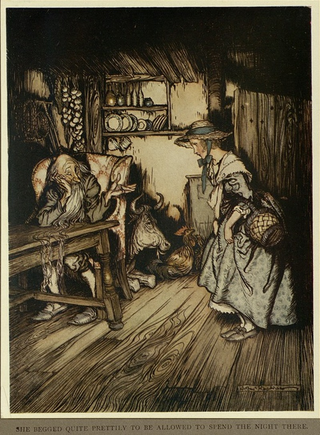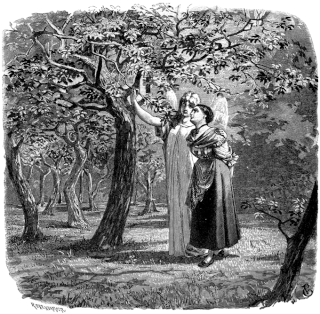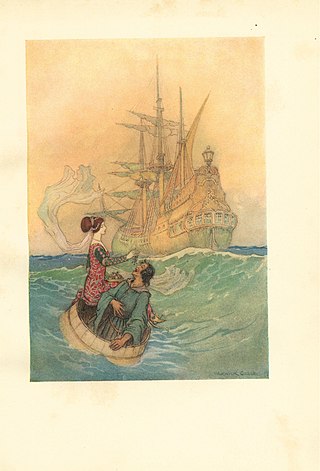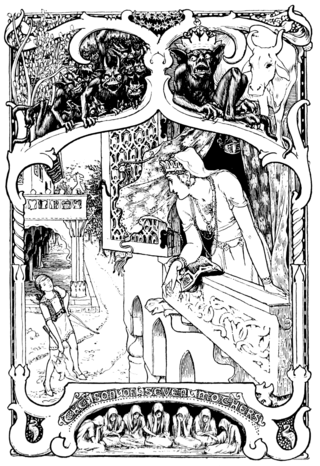| The Pink | |
|---|---|
| Folk tale | |
| Name | The Pink |
| Also known as | The Carnation |
| Aarne–Thompson grouping | ATU 652 |
| Country | Germany |
| Published in | Grimms' Fairy Tales |
"The Pink " or "The Carnation " is a German fairy tale collected by the Brothers Grimm in Grimm's Fairy Tales as tale number 76. [1]
It is Aarne-Thompson type 652, the boy whose wishes always come true. [2]
A childless queen prayed for a child. An angel told her she would have a son with the power of wishing. She had such a son, and every day went with the child to a park where wild beasts were kept. There she washed herself in a stream. One day, a cook stole the child and stained the queen's clothing with hen's blood; then he accused the queen of having let the child be eaten. The queen was imprisoned in a tower to starve, but angels were sent to feed her.
The cook, afraid of being caught, had the prince wish for a castle and a little girl as a companion; they lived there, but the cook grew afraid that the boy would wish for his father and reveal his crime, and told the girl, who had grown to a maiden, that she must murder the boy while he slept and cut out his heart and tongue. The girl refused to murder someone so innocent, but the cook threatened to kill her the next day if she didn't obey. She killed a hind and cut out its heart and tongue; then she had the boy hide in the bed. The cook asked about the murder, and the boy got out of the bed and turned him into a poodle for his betrayal.
The boy wished to go home. The girl was frightened at the thought of the journey, so the boy turned her into a pink (or carnation) and went home, with the poodle running after and the pink in his pocket. He went to his mother, who at first took him for the angels who fed her; he assured her he would free her. Then he worked as a huntsman for his own father. He hunted so much game that the king insisted that the huntsman sit by him at the feast. During the feast the boy reveals he is the king's son and that the cook was behind the evil plan all along. He changed the cook back into his own shape, and the king had him executed; he changed the pink back into the maiden, and because she had brought him up so tenderly and refused to murder him, the king sanctioned their marriage.
The queen was freed, but refused to eat, because angels, having supported her, would now deliver her. She died three days later, and the king died of grief, but the prince married the maiden and they ruled the kingdom together.
German scholar Ulrich Marzolph indicated that an ancestor of the tale type is the Dutch poem Esmoreit . [3] He also mentions the existence of tale type in Judeo-Arabic tradition. [3]
Researcher Richard Dorson reported that the tale type can be found sporadically throughout 15 European countries, mainly in Finland. [4] In addition, Canadian folklorist Carmen Roy stated that the type was "widespread" (tres répandu) across Germany, Scandinavia, Southeastern Europe, Turkey and in the "Indes". [5]
This tale has also been given the alternate title "The Lost Son". In this version the angels are replaced by fairies. [6]

"Snow White" is a German fairy tale, first written down in the early 19th century. The Brothers Grimm published it in 1812 in the first edition of their collection Grimms' Fairy Tales, numbered as Tale 53. The original German title was Sneewittchen; the modern spelling is Schneewittchen. The Grimms completed their final revision of the story in 1854, which can be found in the 1857 version of Grimms' Fairy Tales.

"Rapunzel" is a German fairy tale most notably recorded by the Brothers Grimm and published in 1812 as part of Children's and Household Tales. The Brothers Grimm's story was developed from the French literary fairy tale of Persinette by Charlotte-Rose de Caumont de La Force (1698), which itself is an alternative version of the Italian fairy tale Petrosinella by Giambattista Basile (1634).

"The Goose Girl" is a German fairy tale collected by the Brothers Grimm and first published in Grimm's Fairy Tales in 1815. It is of Aarne-Thompson type 533.

"Brother and Sister" is a European fairy tale which was, among others, written down by the Brothers Grimm. It is a tale of Aarne–Thompson Type 450. In Russia the story was more commonly known as "Sister Alionushka, Brother Ivanushka", and collected by Alexander Afanasyev in his Narodnye russkie skazki.

"Allerleirauh" is a fairy tale recorded by the Brothers Grimm. Since the second edition published in 1819, it has been recorded as Tale no. 65. Andrew Lang included it in The Green Fairy Book.

The Two Brothers is a German fairy tale collected by the Brothers Grimm, tale number 60. It is Aarne-Thompson type 303, "The Blood Brothers", with an initial episode of type 567, "The Magic Bird Heart". A similar story, of Sicilian origin, was also collected by author and folklorist Andrew Lang in The Pink Fairy Book.

"The Three Little Men in the Wood" or "The Three Little Gnomes in the Forest" is a German fairy tale collected in 1812 by the Brothers Grimm in Grimm's Fairy Tales. Andrew Lang included it in The Red Fairy Book (1890) as "The Three Dwarfs," and a version of the tale appears in A Book of Dwarfs (1964) by Ruth Manning-Sanders.

"The Hut in the Forest" is a German fairy tale collected by the Brothers Grimm. Andrew Lang included it in The Pink Fairy Book (1897). It is Aarne-Thompson type 431.
"The Three Little Birds" is a German fairy tale collected by the Brothers Grimm, tale number 96. The story is originally written in Low German. It is Aarne-Thompson type 707, the dancing water, the singing apple, and the speaking bird. The story resembles Ancilotto, King of Provino, by Giovanni Francesco Straparola, and The Sisters Envious of Their Cadette, the story of the 756th night of the Arabian Nights.

"The Girl Without Hands" or "The helpless Maiden" or "The Armless Maiden" is a German fairy tale collected by the Brothers Grimm. It is tale number 31 and was first published in the 1812 edition of Children's and Household Tales. The story was revised by the Grimm brothers over the years, and the final version was published in the 7th edition of Children's and Household Tales in 1857. It is Aarne-Thompson type 706.

"The Twelve Brothers" is a German fairy tale collected by the Brothers Grimm in Grimm's Fairy Tales. Andrew Lang included it in The Red Fairy Book.

"The Water of Life" is a German fairy tale collected by the Brothers Grimm, tale number 97.
Biancabella and the Snake is an Italian literary fairy tale written by Giovanni Francesco Straparola in The Facetious Nights of Straparola.

"The Peasant's Wise Daughter", "The Peasant's Clever Daughter" or "The Clever Lass" is a German fairy tale collected by the Brothers Grimm in Grimm's Fairy Tales as tale number 94. It has also spread into Bohemia and Božena Němcová included it into her collection of Czech national folk tales in 1846.

"The King of the Golden Mountain" is a German fairy tale collected by the Brothers Grimm in Grimm's Fairy Tales.

Peruonto is an Italian literary fairy tale written by Giambattista Basile in his 1634 work, the Pentamerone.
Sun, Moon, and Talia is an Italian literary fairy tale written by Giambattista Basile and published posthumously in the last volume of his 1634-36 work, the Pentamerone. Charles Perrault retold this fairy tale in 1697 as Sleeping Beauty, as did the Brothers Grimm in 1812 as Little Briar Rose.

The Land of Stories is a series of children's fiction, adventure, and fantasy books written by American author, actor, and singer Chris Colfer. The first book, The Wishing Spell, was released on July 17, 2012, with the sixth and final book published in July 2017. Colfer started plans for a prequel series in 2016, and has since published three books in this series, beginning with A Tale of Magic... in 2019.

The Son of Seven Mothers or The Son of Seven Queens is an Indian folktale, first published in the late 19th century by author Flora Annie Steel. It is classified in the international Aarne-Thompson-Uther Index as ATU 462, "The Outcast Queens and the Ogress Queen".
Molla Badji is an Iranian folktale collected and translated by researcher Adrienne Boulvin and published in 1975. It is related to the theme of the calumniated wife and is classified in the international Aarne-Thompson-Uther Index as ATU 707, "The Three Golden Children". These tales refer to stories where a girl promises a king she will bear a child or children with wonderful attributes, but her jealous relatives or the king's wives plot against the babies and their mother. Variants are collected in Iran and in other Iranian languages and among Iranian peoples.